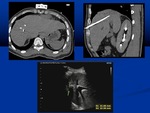Type:
Educational Exhibit
Keywords:
Not applicable, Cancer, Drainage, Biopsy, Ablation procedures, CT, Oncology, Interventional non-vascular, Interventional Radiology
Authors:
J. A. Gómez Patiño, S. Méndez Alonso, M. Alfageme, R. González Costero, A. García Suárez, J. González Plaza, V. Perdomo Suriel, M. L. Collado Torres; Majadahonda/ES
DOI:
10.26044/ecr2020/C-13020
Findings and procedure details
IMACTIS CT®-Navigation system is composed of the following components: (Figures 2, 3)
1. A navigation station that includes:
a. A computer
b. A touchscreen
c. An electromagnetic transmitter to be attached to the patient’s skin
d. An electromagnetic receiver to be attached to the needle holder
2. Navigation software that has been specifically designed for CT-guided percutaneous procedures
3. A packet of consumables that includes:
a. A single-use sterile needle holder
b. A single-use sterile drape to cover the receiver
c. Hardware that contains the software parameters and which enables the software to be launched [10]
The operating principle of the navigation system is based on the localization (position and orientation), the electromagnetic transmitter that is attached to the patient’s skin and the receiver in the needle-holder, the locating device makes it possible to display the needle anticipated trajectory in real time in two reconstructed sections pushed from the CT scanner to the station (Figure 4)
The physician moves the needle-holder over the patient’s skin and uses it as guide to explore the anatomy and to plan the needle trajectory. Multi-probe procedures are possible.
We show the utility of this device in different interventional procedures: biopsy, marking drainage, percutaneous infiltration and ablation (Radiofrequency, microwave) as an easy and faster alternative. IMACTICS also allows to performance procedures with local anesthesia or conscious sedation in high risk patients ASA III (Figures 5 to 20)










![Fig. 11: Figures 11, 12. Male 36y echinococcal cyst WHO classification type CE3b treated with large bore percutaneous drainage and several sessions of hypertonic saline washes with poor response (Red arrow) [11] Posterior treatment with radiofrequency assisted with IMACTIS, intercostal and subdiaphragmatic location and poor visualization cranial part in echography. Good result in post treatment control echography three months later (Green arrow)](https://epos.myesr.org/posterimage/esr/ecr2020/155778/media/861819?maxheight=150&maxwidth=150)




![Fig. 16: Figures 16, 17. Female 39y CT percutaneous infiltration assisted with IMACTIS for the diagnostic and treatment of Alcock’s neuralgia. Local anesthesia. Screenshot planning phase. 21G Chiba needle tip is advanced through the gluteal muscle to the fascia of the internal obturator muscle where the pudendal nerve protrudes from a small deficit of the fascia. Injection of 1-3ml of contrast medium (Red arrow) confirms the appropriate needle placement near the pudendal nerve but outside from the vessels. A mixture of corticosteroids and local anesthetics is injected to reduce the pain caused by the neuralgia [12]](https://epos.myesr.org/posterimage/esr/ecr2020/155778/media/861825?maxheight=150&maxwidth=150)




